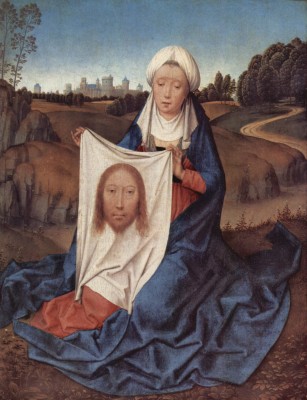The tiny pink bundle next to me wiggles a bit. I stroke my daughter’s soft brown hair and smile as she studies the pattern on the pillow next to her, her eyebrows knit seriously like her mom’s often are. I admire her little nose, her tiny eyelashes, and her precious ears that stick out a bit at the top, also like mine. I marvel at the miracle of her who was once, impossibly, curled up inside me and smile. My Veronica, now three weeks old.
We named her after St. Veronica, the woman who wiped the face of Jesus with her veil as He was carrying the cross, after which a miraculous image of the Holy Face was left behind on the fabric. I’ve long been familiar with the saint and have always been taken by her very feminine and equally courageous act. I couldn’t imagine the enormous temptation to hide from the soldiers and their instruments of torture as they escorted Jesus down the street and yet she didn’t, instead coming to her Lord’s aid in the face of danger. Veronica reminds me of the strength, dignity, and beauty of a Christian woman’s life well-lived and the great witness of love to the world that we can be.
What I hadn’t known before this past year, though, was that the Church still has the veil of Veronica. She’s kept it safe for two millennia, and a few decades ago conducted scientific research on it which yielded some incredible discoveries.
I was first introduced to the relic and its history while reviewing Witnesses to Mystery from Ignatius Press. An incredibly thorough look at the history and scientific study of the relics of the Church, the seventh chapter is dedicated entirely to Veronica’s veil.
Sometimes referred to as the Veil of Manoppello, it’s kept in a church in the town of Manoppello, Italy. The veil itself is made of byssus, which was in Jesus’s time and remains the most expensive material in the world. Also known as sea silk, it’s produced from mother-of-pearl and is extremely thin, iridescent, translucent, fireproof, and can stand up to things like alcohol and diluted acid. Witnesses to Mystery mentions that byssum appears in the Old Testament as the material of an archpriest’s robe and again in Revelation as the material of the gown worn by the Bride of the Lamb (p. 243).
Another astonishing thing I learned about the veil is that it lines up perfectly with the features on the Shroud of Turin when one is laid on top of the other, even down to the placement of the wounds on the Holy Face. In the Middle Ages it was nicknamed “the Veronica,” a combination of the Latin vera or real and the Greek eikon or image. Having characteristics of a painting, drawing, hologram, and photograph, the image of the Holy Face changes depending on the light and how one looks at it (218, 230).
This book was a favorite of mine to meditate on last Lent, with large, beautiful pictures of the many relics in the Church’s treasury. Most striking of those for me, however, remains the images of the Veronica. How good Our God is to leave behind an image of His Holy Face for us to remember Him by, a visible token of His love. And we wouldn’t have this precious miracle if our sister hadn’t had the courage and love to come to Jesus’s side during His time of need.
St. Veronica, please pray for our courage and love to be faithful to God despite difficulty and fear, so that our lives might reveal the Holy Face of Love Incarnate to the world.
Art/Photography: Veronica holding her veil, Hans Memling, PD/CC/SA, http://en.wikipedia.org/wiki/Veil_of_Veronica#mediaviewer/File:Hans_Memling_026.jpg
About the Author

Guest
We welcome guest contributors who graciously volunteer their writing for our readers. Please support our guest writers by visiting their sites, purchasing their work, and leaving comments to thank them for sharing their gifts here on CatholicMom.com. To inquire about serving as a guest contributor, contact editor@CatholicMom.com.



.png?width=1806&height=731&name=CatholicMom_hcfm_logo1_pos_871c_2728c%20(002).png)
Comments